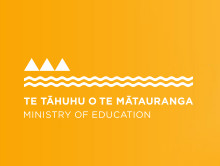I Muri i te Pānui Pukapuka
After Reading
He ngohe aromatawai, he ngohe whakawhānuitanga ēnei.
Possible assessment and extension activities.
1. Ka arotake ngā ākonga i ā rātou rārangi mōhio me te matapaki i ā rātou akoranga hou i muri i te pānui i tēnei pukapuka.
Students review their list and discuss what they now know after reading the material.
2. Tirohia te pātai tuarua i te wāhanga ‘I Mua i te Pānui Pukapuka’ (‘kua ākona e au’). I muri i te pānui pukapuka ka whakakīkī ngā ākonga i te pou tuarua e pā ana ki ā rātou akoranga. Ka mutu te whakakīkī i te whārangi, ka matapakina ngā ōritenga me ngā rerekētanga.
After reading, the students fill in the second column with what they have learnt. See question 2 from Before Reading (‘kua ākona e au’). Students will fill in the sheet and discuss what the similarities and differences are.
3. Me matapaki tahi ngā ākonga i ngā arotahinga e whai ake nei mō ētahi momo reo e toru e tauira mai ana i Te Tautoko 70:
- He aha ngā tino āhua o te momo reo i ako ai tātou?
- Homai kia rima ngā tauira mō ētahi o ngā āhua.
- Whakaatu mai he tuhinga e taunaki ana i tō mōhio me tō mārama ki tērā momo reo. E tika ana kia āhei ngā ākonga ki te tautohu i ngā āhua o te reo kei roto i ā rātou ake tuhinga.
Ask students to discuss the following question and instructions regarding any of the three language styles presented in Te Tautoko 70:
- What are the main features of the language style that we have learnt about?
- Give me five examples of some of the features.
- Produce a piece of writing that reflects your knowledge and understanding of this language style. (Students should be able to identify the language features they have included in their piece.)
He hokinga whakamuri hei kōkiringa whakamua
Ideas for reflecting in learning and planning next learning steps
1. Hoatu tētahi atu kōrero taki nō pukapuka kē ki ngā ākonga, ka akiaki rātou ki te tautohu i ētahi āhuatanga reo o taua kōrero taki i kitea i te pukapuka Te Tautoko 70.
Give students another recount text from another book and ask them to identify some examples of the language features of recount text that they found in the articles in Te Tautoko 70.
2. Hoatu ētahi atu whiti whakangahau nō pukapuka kē ki ngā ākonga, ka akiaki rātou ki te tautohu i ētahi āhuatanga reo o taua whiti whakangahau i akohia i te pukapuka Te Tautoko 70.
Give students some other poetry from another book and ask them to identify some examples of the language features of recount text that they learnt from the poem in Te Tautoko 70.
3. Rangahaua ētahi pakihi, ētahi hinonga rānei ā te Māori hei whakaatu tuhinga taki whānui e pā ana ki aua rōpū whakariterite me ngā tāngata nō rātou aua rōpū rā.
Research other Māori owned businesses or enterprises and produce recount texts about these organisations and the people who own them.



